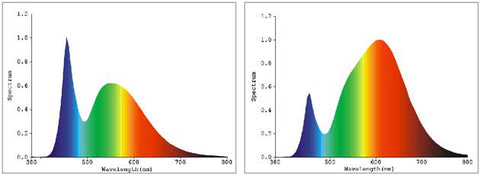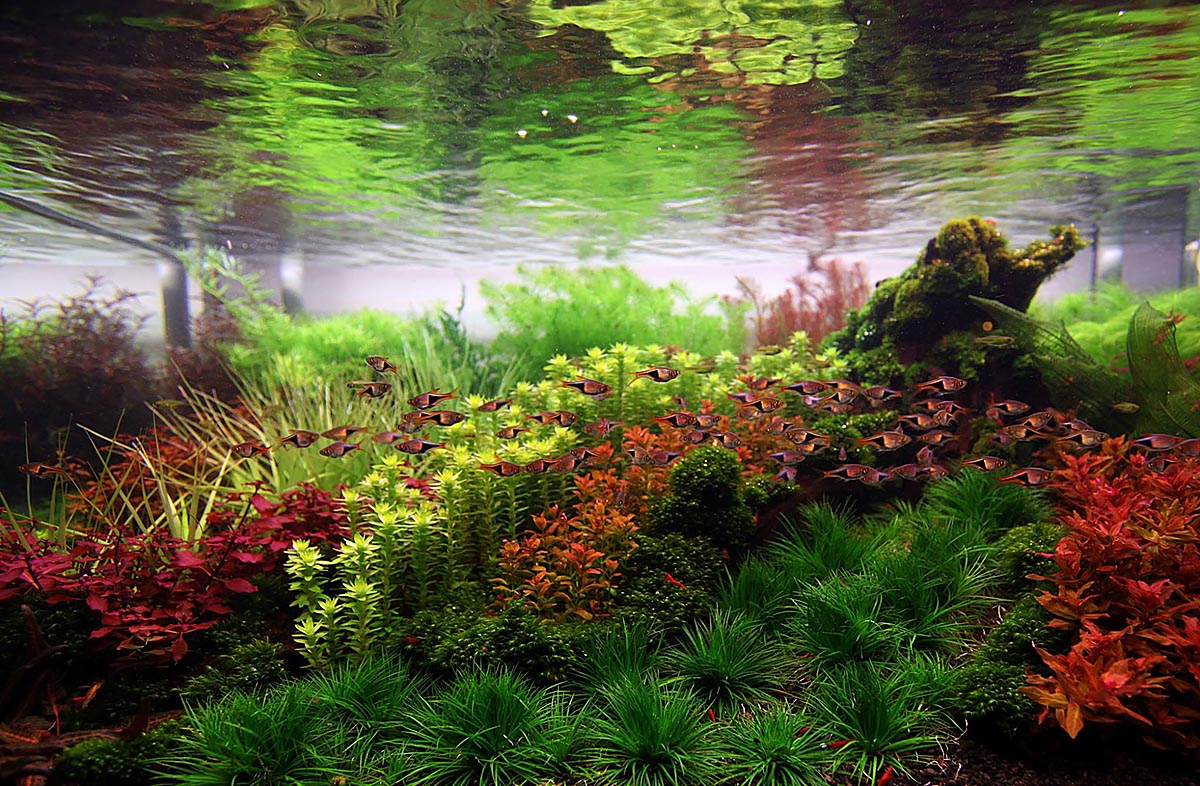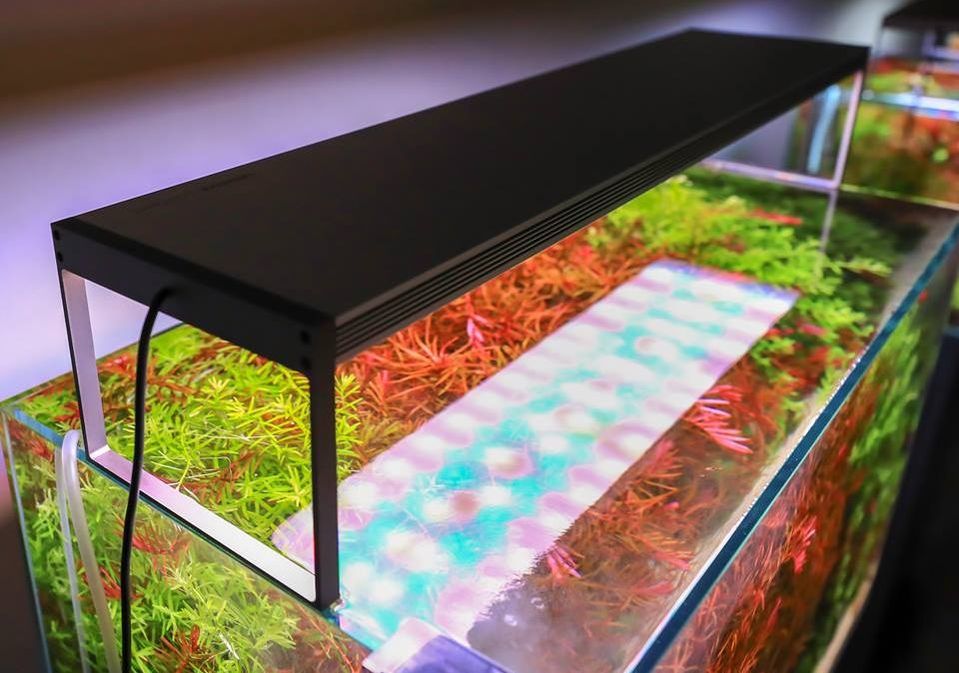Lets start by reading spectrum charts
An example of a light spectrum chart of a T5 bulb is given on the left below. The amount of light produced for a particular spectrum segment is the area under the curve. This bulb has a balance of red/green/blue which will give the bulb a relatively neutral white appearance overall. The spikes comes from particular phosphors used in the manufacture of florescent bulbs. Different bulbs will have different spikes in their spectrum profiles. Visually, it can be difficult to extrapolate visual color tone of bulbs from reading spectrum profile charts unless you have a lot of experience. It is always a good idea to check out aquarium lights in person.
Spectrum also changes with depth. Water absorbs red light more readily than blue, which has a higher frequently/energy. About 30% of red light is loss at 2 feet of depth. The spectrum charts below show how the spectrum curves shift in water. (the spectrum chart Y axis is relative) Manufacturers rarely go to such lengths to show this data.
Most standard aquarium lights are deficient
A 6500k plain white LED diode (left) vs a 2700k warm white LED diode (right). These are commonly used for household lighting & often make up the bulk of cheap aquarium LED light fixtures. Plain white 6500K diodes lack adequate red spectrum, which is why using LED fixtures with plain white LEDs often result in washed out visual colors, and poorer pigmentation in red plants even though plants may still grow. Warm white LEDs often work better for growing plants, however, they cast a yellowish visual tone on the tank as they lack adequate blue spectrum.
Most commercial T5 fixtures, and almost all commercial LEDs come with a spectrum that I find to be deficient in red. This is especially so for LED fixtures that use purely white diodes. They will have a similar overall spectrum profile as the 6500K plain white LED diode above, which may grow plants ok, but give poor visual saturation & contrast and also is poorer at growing red plants compared to fixtures with higher red spectrum in their profile.
A better spectrum profile
Why red and blue parts of the spectrum are important in planted aquarium lighting.
Better visual impact on coloured plants. Most white lights (bulbs/LEDs) lack red/blue by default. This causes tanks to look washed out. Colour plants pop a lot more when there is stronger red/blue lighting. However, there must be enough green/orange/yellow spectrum present as well to give a balanced visual output.
Better coloured pigmentation in certain plants. While all wavelengths of light between 400nm and 700nm contribute to photosynthesis, stronger red/blue stimulate pigmentation in certain plants. This means that many red plants grow redder when exposed to strong red/blue spectrum. Many people think that good pigmentation in coloured plants is achieved by nutrient dosing alone – when actually lighting plays a very important role.
Anecdotal evidence also suggests that stronger red/blue light produces plants in significantly better growth forms – plants grow more compact with fuller leaves.
What to look for in planted tank light spectrum
For T5 lighting
At the minimum, we recommend 50% of the tubes in a T5 array to be changed to pink/red gro-tubes. (meaning 2/4 of a 4 tube T5 array). Our own farm tank’s T5 tube selection is shown here (no white tubes !) :
Tank grown using the T5 tube selection above, which gives pretty strong color saturation in reds and blues while still allowing different shades of pinks & orange tones to be well rendered. If only pink/blue bulbs were used, tank may look overly red saturated visually – and midtones such as orange and pink would look more reddish than their respective colors.
For LED lighting
RGB (Red, Green, Blue) LED fixtures that use a mix Red, blue & green diodes (and less plain white LEDs) have high peaks in Red, blue and green wavelengths. These kind of fixtures perform much better than LED fixtures that use plain white LED diodes. The few commercial LEDs that do this very well are includes the Chihiros series, ADA solar RGB & WEEK Aqua series. These all have large RGB spectrum spikes with their red, green, blue diodes but with large spectrum gaps in between. This spectrum profile gives very high saturation for red, blues and green tones, which really makes red plants pop in the tank. This is much more apparent in real life than even seen in videos/photos.
Spectrum profile for the ADA solar RGB LED below:

A comparison of ADA solar RGB and some other lighting fixtures can be seen in this video:
A comparison of Chihiros vivid (similar spectrum to ADA solar RGB) and other chihiros fixtures:
Other tank examples
The T5 selection favored by Tom barr shows liberal use of red/blue tubes.
The T5 selection by Joe Harvey forgoes white tubes almost entire, and focus on a mix of pink/purple tubes with a yellow tube for balance. Surprisingly, due to human eye sensitivity to green, it takes only a little to counter balance strong red/blue tones.
The Twinstar series of LED are popular; the S series is what you want. The cheaper version of this light that is similar is the Chihiros WRGB. Twinstar S probably has better build quality but comes at higher price.
When to use more green?
Counter to the examples above, older ADA lighting systems have come up with light spectrums with high amounts of green rather than Red/blue. (i.e. NAG Green bulb for their Metal halide fixtures). These wash out red plant colors but work to make aquascapes with green only pop.
If you find intense green tones attractive, choosing fixtures heavy in green spectrum will work to give the tank a green glow.
Spectrum correlation to algae?
There is persistent myth out there that having more blue light gives rise to more algae. Having seen thousands of tank examples, we don’t see this correlation arising at all. This is also a consistent observation by other expert plant growers such as Tom barr. Algae is always closely linked with overall plant health and tank cleanliness, organic waste levels. Higher light intensity triggers algae faster in tanks with trigger factors but spectrum (as far as hobbyist tanks are concerned) are a non factor.
Here are link to learn more about:













